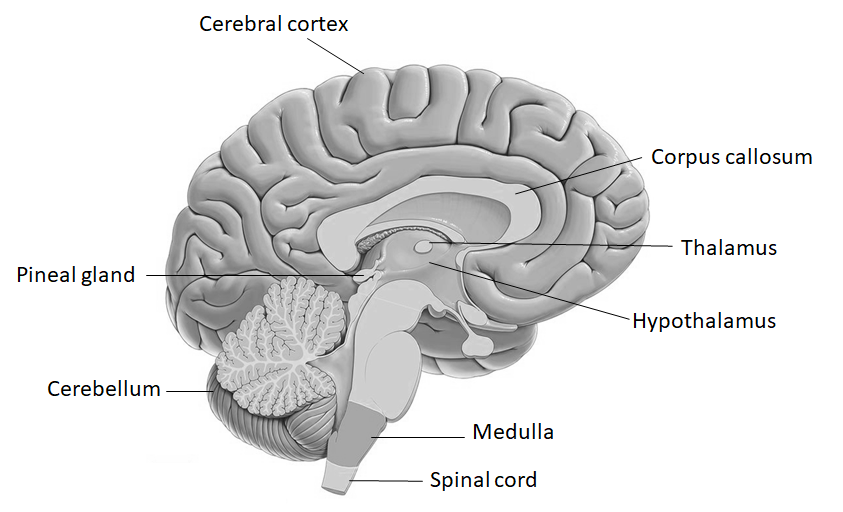Answer
394.2k+ views
Hint: The balance and posture centre of the body is situated in the back of the head. This part of the brain is responsible for synchronizing voluntary movements.
Complete answer:
The cerebellum is located at the back of the head. Its purpose is to coordinate voluntary muscle movements and to maintain posture, balance, and equilibrium.
- The hypothalamus is situated on the lower surface of the brain. It is present just below the thalamus and above the pituitary gland, to which it is attached by a stalk. The function of the hypothalamus is to connect the nervous system to the endocrine system through the pituitary gland. It also secretes hormones.
- The medulla oblongata is a part of the brain that extends into the spinal cord and it is a centre for respiration and circulation. Sensory and motor neurons that arise from the forebrain and midbrain pass through the medulla.
- The cerebrum is situated within the bony skull. The cerebral hemispheres make up the largest part of the human brain. It is related to higher brain function such as thought and action.
- The cerebellum is located at the back of the head. It is responsible for a number of purposes including motor skills such as balance, coordination, and posture.

So, the correct answer is “cerebellum”.
Note: Damage to the cerebellum can result in loss of coordination of motor movement i.e. asynergia, the incapability to judge distance and when to stop i.e. dysmetria, the incapability to perform rapid alternating movements i.e. adiadochokinesia, movement tremors, staggering, a wide- based walking tendency toward falling, weak muscles, slurred speech, and abnormal eye movements.
Complete answer:
The cerebellum is located at the back of the head. Its purpose is to coordinate voluntary muscle movements and to maintain posture, balance, and equilibrium.
- The hypothalamus is situated on the lower surface of the brain. It is present just below the thalamus and above the pituitary gland, to which it is attached by a stalk. The function of the hypothalamus is to connect the nervous system to the endocrine system through the pituitary gland. It also secretes hormones.
- The medulla oblongata is a part of the brain that extends into the spinal cord and it is a centre for respiration and circulation. Sensory and motor neurons that arise from the forebrain and midbrain pass through the medulla.
- The cerebrum is situated within the bony skull. The cerebral hemispheres make up the largest part of the human brain. It is related to higher brain function such as thought and action.
- The cerebellum is located at the back of the head. It is responsible for a number of purposes including motor skills such as balance, coordination, and posture.

So, the correct answer is “cerebellum”.
Note: Damage to the cerebellum can result in loss of coordination of motor movement i.e. asynergia, the incapability to judge distance and when to stop i.e. dysmetria, the incapability to perform rapid alternating movements i.e. adiadochokinesia, movement tremors, staggering, a wide- based walking tendency toward falling, weak muscles, slurred speech, and abnormal eye movements.
Recently Updated Pages
How do you arrange NH4 + BF3 H2O C2H2 in increasing class 11 chemistry CBSE

Is H mCT and q mCT the same thing If so which is more class 11 chemistry CBSE

What are the possible quantum number for the last outermost class 11 chemistry CBSE

Is C2 paramagnetic or diamagnetic class 11 chemistry CBSE

What happens when entropy reaches maximum class 11 chemistry JEE_Main

Calculate the volume occupied by 88 gram of CO2 at class 11 chemistry CBSE

Trending doubts
Difference between Prokaryotic cell and Eukaryotic class 11 biology CBSE

Fill the blanks with the suitable prepositions 1 The class 9 english CBSE

Write an application to the principal requesting five class 10 english CBSE

Difference Between Plant Cell and Animal Cell

a Tabulate the differences in the characteristics of class 12 chemistry CBSE

Change the following sentences into negative and interrogative class 10 english CBSE

What organs are located on the left side of your body class 11 biology CBSE

Discuss what these phrases mean to you A a yellow wood class 9 english CBSE

List some examples of Rabi and Kharif crops class 8 biology CBSE



